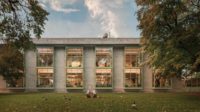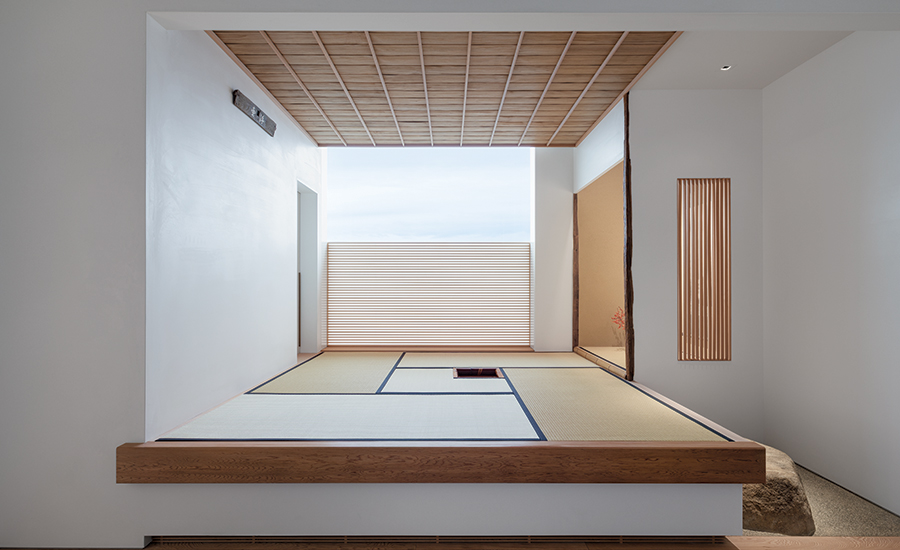Private Residence by Hiroshi Sugimoto, NMRL, and YUN Architecture
New York

A traditional Japanese entry corridor leads to the tearoom.
Photo © Devon Banks

Sugimoto video artwork hangs on one wall (shown) of the elevator lobby, while one of his photographs is displayed nearby in the apartment’s foyer.
Photo © Hiroshi Sugimoto

Sugimoto video artwork hangs on one wall of the elevator lobby, while one of his photographs is displayed nearby (shown) in the apartment’s foyer.
Photo © Devon Banks

The tearoom (shown) includes a niche with a photo by Sugimoto.
Photo © Devon Banks

The tearoom includes a niche with a photo by Sugimoto (shown).
Photo © Hiroshi Sugimoto

He and his team designed the sushi bar and stools, and the table and helicoidal chairs in the dining salon (shown), as well as the furniture for the sitting area nearby.
Photo © Devon Banks

He and his team designed the sushi bar and stools, and the table and helicoidal chairs in the dining salon, as well as the furniture for the sitting area nearby (shown).
Photo © Devon Banks

The kitchen cabinets are hand-hammered metal.
Photo © Devon Banks

An alcove with a Sugimoto photo and a stone from a Japanese garden is next to the family room.
Photo © Devon Banks

As in the family room and other living spaces, the windows have operable wood screens that can be positioned to show only the sky or only the city below.
Photo © Devon Banks

One of the master baths has a shower framed by slabs of Komatsu stone.
Photo © Hiroshi Sugimoto

In another bath, a cypress tub sits on recycled Kyoto stone and the ceiling is cedar.
Photo © Devon Banks

Sugimoto designed the furniture in the master bedroom.
Photo © Devon Banks













What kind of apartment interior would you deem appropriate for a supertall tower in New York with an austere gridded design? Would you create an ornately decorated inner world that has nothing to do with the attenuated shaft? Or would you, as artist Hiroshi Sugimoto did, attempt to be minimal and still sumptuous? Sugimoto and his Tokyo-based architectural studio, New Material Research Laboratory (NMRL), worked with a local architect, YUN Architecture, to create an elegant gesamtkunstwerk based upon Japanese culture, craft, and materials.
Additional Content:
Jump to credits & specifications
Although Sugimoto is best known in the U.S. for his strikingly ethereal, often enigmatic photographs, he turned to architecture and design, he says, because of museum spaces he found overly sculptural for exhibitions of his work, often created by high-profile architects. In 2008, he joined up with architect Tomoyuki Sakakida to found NMRL, which led to such projects as the strongly linear concrete and weathering-steel Enoura Observatory in Kanagawa Prefecture.
In the case of this New York interior, Sugimoto and NMRL were responsible for almost every element in the apartment—from the fittings and finishes to the design of the helicoidal dining chairs and other furnishings—including strategically placing Sugimoto’s photographs and sculptures throughout. True, certain items, such as the kitchen’s French gas oven, are not from his hand, but, overall, the custom-crafted interior and almost all its components are a quietly forceful testament to Sugimoto’s distaste for mass-produced objects.
The owners, a married couple who collect contemporary art, originally wanted Sugimoto to create just a Japanese tearoom within the 8,000-square-foot apartment. They had seen one he conceived for his own studio in Manhattan, and they visited a Tokyo restaurant, Sahsya Kanetanaka, that he completed in 2013. As work progressed, they asked him to take over the entire project. In searching for a local architect, Sugimoto found Susan Yun and her associate principal Felix Ade through architect Annabelle Selldorf, for whom Yun had worked. The elaborate four-year design and construction process—executed by New York contractor Xhema—wrapped up in 2018. “The clients even came to Japan to visit stone quarries and look at wood with me,” says Sugimoto.
The apartment, which occupies an entire floor high in the concrete-frame structure, was formed from two apartments that were sold as raw space (Yun did have to change certain plumbing and mechanical components). The tower’s square floor plan, where perimeter beams and columns form the exterior structural “tube,” permitted column-free rooms to be arranged along the four walls of the building and arrayed around the structural elevator core.
As rooms unfold from the more public to private spaces, surprises await. Entering the apartment through the narrow guest hall, you first encounter the pristine tearoom. Beyond is a large dining salon, facing west and south, where a long sushi bar is separated from the dining table by a parapet-like slab of komatsu stone and two bonsai ficus trees. (There is no need to search for a neighborhood sushi place—Sugimoto located a chef for his clients.) Along the south wall are the kitchen and family room; in the latter space, a luminous, deeply coved ceiling contrasts with the flat planes hovering above other rooms, which nevertheless reach heights of about 12 feet. Private areas are located on the east and north: an office, guest bedrooms and bathrooms, and ultimately a master suite with his-and-hers baths.
While the plan is characterized by rectilinear or square rooms, Sugimoto varied the austere texture and tones with rare materials. Weathered stone from the streets of Kyoto pave the guest lobby. Unglazed gray custom tiles, made with traditional clay from Nara, surface other corridors. The traditional tatami mats in the tearoom may seem expected, but not the grainy ancient Yakasugi cedar (no longer available) for the dining salon floor. Similarly, the wide, hand-chiseled chestnut boards in the master bedroom—and, for that matter, the Towada tuff stone for the bathrooms—demonstrate the dramatic power of exotic materials.
The walls glow with the soft sheen of Shikkui plaster finish—it took Japanese artisans two months to apply the three coats of the lime-based mix made in Tagawa. This arduous exercise comes with environmental benefits: the plaster absorbs carbon dioxide, and purportedly resists bacteria, fungi, and mold. Yun also notes that certain small features will help prevent cracking from lateral movement in the chimney-like skyscraper.
Aside from the exquisite details and materials, there is still the elephant in the room: the view. The city spreads out like a carpet in all directions, framed in 10-foot-by-10-foot windows, six on each elevation. Yet, despite the potential for full views of the Empire State Building or Central Park, Sugimoto designed window treatments that can eliminate everything but the sky. With traditional Shoji screens in mind, Sugimoto and NMRL have created operable wood and translucent acrylic panels that can be positioned to show only the city beneath or the heavens above.
Looking at the views, Sugimoto’s horizontal seascapes come to mind. The calm and mystery of his two-dimensional photographs is in the interior’s three-dimensional spaces. Although each room has its own distinct character, the entirety achieves an arresting if static suspension in space and time. This oasis in the sky intriguingly provides an apt response to the container’s liminal architecture.
CreditsArtist: Hiroshi Sugimoto
Design architect: New Material Research Laboratory—Tomoyuki Sakakida, partner and director; Naoko Kawamura, project manager; Yuichi Hashimura,
Architect of record: YUN Architecture—Susan Yun, principal; Felix Ade, associate principal; Georgia Read, project architect
Lighting: KGM Architectural Lighting
Engineers: Murray Engineering (structural); Altieri Sebor Wieber (m/e/p)
General contractor: Xhema
Size: 8,000 square feet
Cost: withheld
Completion date: December 2018 |
SpecificationsAcoustical ceiling Baswaphon
Solid surfacing Corian
Dimmers Lutron
Paint Benjamin Moore |




















